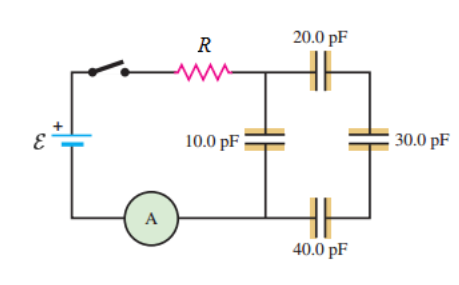In the circuit shown in (Figure 1), the capacitors are all initially uncharged and the battery has no appreciable internal resistance. Assume that E = 51.0 V and R = 23.0 2.
In the circuit shown in (Figure 1), the capacitors are all initially uncharged and the battery has no appreciable internal resistance. Assume that E = 51.0 V and R = 23.0 2.
College Physics
11th Edition
ISBN:9781305952300
Author:Raymond A. Serway, Chris Vuille
Publisher:Raymond A. Serway, Chris Vuille
Chapter1: Units, Trigonometry. And Vectors
Section: Chapter Questions
Problem 1CQ: Estimate the order of magnitude of the length, in meters, of each of the following; (a) a mouse, (b)...
Related questions
Question

Transcribed Image Text:The image depicts an electrical circuit consisting of a power source (denoted as ε), a resistor (R), an ammeter (A), and a combination of capacitors.
1. **Power Source (ε)**: The circuit begins with a voltage source symbolized by ε. This is the driving force that provides electrical energy to the circuit.
2. **Switch**: The circuit includes a switch that controls the flow of current. When closed, it completes the circuit allowing current to flow through.
3. **Resistor (R)**: Connected in series with the rest of the circuit, the resistor is marked with a zigzag symbol. It is a component that restricts the flow of electric current.
4. **Ammeter (A)**: Connected in series, the ammeter measures the current flowing through the circuit. It appears as a circle with the letter 'A' inside.
5. **Capacitors**: To the right of the circuit are multiple capacitors:
- A 10.0 pF (picofarad) capacitor directly in series after the resistor.
- Three capacitors are in parallel with each other:
- A 20.0 pF capacitor
- A 30.0 pF capacitor
- A 40.0 pF capacitor
The capacitors are connected in such a way that the total capacitance is affected by both series and parallel combinations. The current flowing through the ammeter depends on how the capacitors impact the overall impedance of the circuit.
![**Educational Website Transcription:**
**Circuit Analysis Exercise**
In the circuit shown in (Figure 1), the capacitors are all initially uncharged, and the battery has no appreciable internal resistance. Assume that \( \mathcal{E} = 51.0 \, \text{V} \) and \( R = 23.0 \, \Omega \).
---
### Part D
**Problem Statement:**
After the switch is closed, find the maximum charge on the 40.0 pF capacitor.
**Answer Format:**
Express your answer in picocoulombs.
**Input Section:**
\( q_{40} = \) [______] \(\text{pC}\)
[Submit Button] [Request Answer]
---
### Part E
**Problem Statement:**
After the switch is closed, find the maximum potential difference across the 10.0 pF capacitor.
**Answer Format:**
Express your answer in volts.
**Input Section:**
\( V_{10} = \) [______] \(\text{V}\)
[Submit Button] [Request Answer]
---
### Part F
**Problem Statement:**
After the switch is closed, find the maximum potential difference across the 20.0 pF capacitor.
**Answer Format:**
Express your answer in volts.
**Input Section:**
\( V_{20} = \) [______] \(\text{V}\)
[Submit Button] [Request Answer]](/v2/_next/image?url=https%3A%2F%2Fcontent.bartleby.com%2Fqna-images%2Fquestion%2F7a931645-54a1-474a-bda2-4c874edd548a%2Fdd67ddb2-2aee-401c-985c-58c1b9791a3a%2Fumjvg4r_processed.png&w=3840&q=75)
Transcribed Image Text:**Educational Website Transcription:**
**Circuit Analysis Exercise**
In the circuit shown in (Figure 1), the capacitors are all initially uncharged, and the battery has no appreciable internal resistance. Assume that \( \mathcal{E} = 51.0 \, \text{V} \) and \( R = 23.0 \, \Omega \).
---
### Part D
**Problem Statement:**
After the switch is closed, find the maximum charge on the 40.0 pF capacitor.
**Answer Format:**
Express your answer in picocoulombs.
**Input Section:**
\( q_{40} = \) [______] \(\text{pC}\)
[Submit Button] [Request Answer]
---
### Part E
**Problem Statement:**
After the switch is closed, find the maximum potential difference across the 10.0 pF capacitor.
**Answer Format:**
Express your answer in volts.
**Input Section:**
\( V_{10} = \) [______] \(\text{V}\)
[Submit Button] [Request Answer]
---
### Part F
**Problem Statement:**
After the switch is closed, find the maximum potential difference across the 20.0 pF capacitor.
**Answer Format:**
Express your answer in volts.
**Input Section:**
\( V_{20} = \) [______] \(\text{V}\)
[Submit Button] [Request Answer]
Expert Solution
Step 1: Determine the given data:

Step by step
Solved in 5 steps with 5 images

Knowledge Booster
Learn more about
Need a deep-dive on the concept behind this application? Look no further. Learn more about this topic, physics and related others by exploring similar questions and additional content below.Recommended textbooks for you

College Physics
Physics
ISBN:
9781305952300
Author:
Raymond A. Serway, Chris Vuille
Publisher:
Cengage Learning

University Physics (14th Edition)
Physics
ISBN:
9780133969290
Author:
Hugh D. Young, Roger A. Freedman
Publisher:
PEARSON

Introduction To Quantum Mechanics
Physics
ISBN:
9781107189638
Author:
Griffiths, David J., Schroeter, Darrell F.
Publisher:
Cambridge University Press

College Physics
Physics
ISBN:
9781305952300
Author:
Raymond A. Serway, Chris Vuille
Publisher:
Cengage Learning

University Physics (14th Edition)
Physics
ISBN:
9780133969290
Author:
Hugh D. Young, Roger A. Freedman
Publisher:
PEARSON

Introduction To Quantum Mechanics
Physics
ISBN:
9781107189638
Author:
Griffiths, David J., Schroeter, Darrell F.
Publisher:
Cambridge University Press

Physics for Scientists and Engineers
Physics
ISBN:
9781337553278
Author:
Raymond A. Serway, John W. Jewett
Publisher:
Cengage Learning

Lecture- Tutorials for Introductory Astronomy
Physics
ISBN:
9780321820464
Author:
Edward E. Prather, Tim P. Slater, Jeff P. Adams, Gina Brissenden
Publisher:
Addison-Wesley

College Physics: A Strategic Approach (4th Editio…
Physics
ISBN:
9780134609034
Author:
Randall D. Knight (Professor Emeritus), Brian Jones, Stuart Field
Publisher:
PEARSON